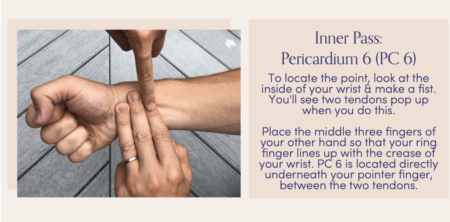PC 6, short for Pericardium 6, is the 6th point on the Pericardium channel. The point is found between the two tendons on the inside of the wrist, about three fingers below the wrist crease. PC 6 is most famously known for its use in motion sickness bracelets, but it has a plethora of other uses too.
We can look at the functions of PC 6 in a few different ways, so we’ll start from a Chinese medicine perspective. PC 6 is said to have a descending function on the qi, or energy, in the body and relieves nausea and vomiting by descending qi. Similarly, it has a harmonizing effect on the stomach and relieves stomach pain. The point is also said to loosen the chest and eliminate agitation in the body. It is a very relaxing point, as it calms the Heart and Shen, aka the spirit, and can treat anxiety and insomnia.
PC 6 has a deeper connection to the body through its connection with the “Yin Wei” which is one of the Eight Extraordinary Vessels in the body. The Yin Wei has strong connections to the heart, the chest, and the emotions a person feels. Treating the Yin Wei can help a person let go of traumas of the past, and help a person be present in the current moment. PC 6 is considered the “opening” point for the Yin Wei and it’s how we access the Yin Wei vessel.
From a Western medical perspective, PC 6 is noted to treat a long string of conditions including heart pain and palpitations, pain in the hypochondriac region, nausea and vomiting, hiccups, mental disorders, epilepsy, insomnia, fever, irritability, malaria, and carpal tunnel syndrome. While this may seem like a lot of different symptoms that it can treat, it explains why PC 6 is one of the most commonly used acupuncture points.
One of my favorite reasons to use PC 6 is because of its connection to the parasympathetic nervous system, also known as the “rest and digest” state. It’s a terrific point for anyone dealing with anxiety and insomnia and is a fan-favorite among the acupuncture community for this reason. PC 6 accesses the vagus nerve, one of the longest and most complex of all the cranial nerves, which is part of the parasympathetic nervous system. By needling PC 6, we’re telling the body to go into its parasympathetic state, which is when the body is relaxed and no longer in fight or flight mode.
Additionally, PC 6 helps to treat anxiety by relaxing the diaphragm. While we may think that the lungs are the only organ to have an effect on our breathing, the diaphragm is also a major player in how effectively we breathe. PC 6 relaxes the diaphragm and allows a person to take a deep, diaphragmatic breath, which allows you to feel calmer, grounded, and at peace.
PC 6 is also a pregnancy-approved acupuncture point and has the function of “calming the fetus.” It also promotes lactation for people who are breastfeeding. PC 6 is a great point to use for people trying to get pregnant as well, as it lowers stress levels in the body and gets the body back to its parasympathetic state.
Try it Yourself

You can request that your acupuncturist use PC 6 during your next treatment, or you can use it on your own using acupressure. Acupressure is the simple act of manually pressing on an acupuncture point, but acupressure magnets may be used instead to make things even easier. If you don’t have access to acupressure magnets, you can DIY them yourself by placing a small bean, like a lentil, over an acupuncture point and taping it down with a piece of medical tape. Additionally, the magnets from acupressure magnets can be removed from the circular medical adhesive and reused with new medical tape.
The post It’s All in the Wrist: Introducing you to PC 6 first appeared on The Yinova Center.